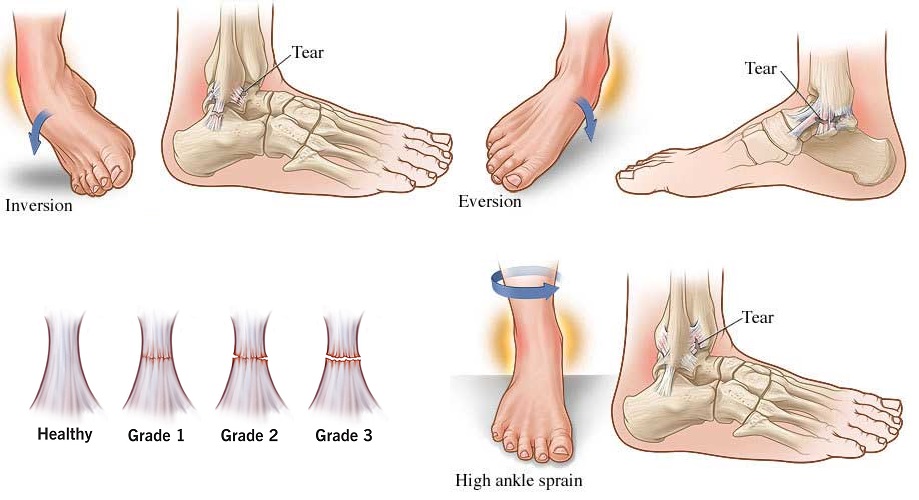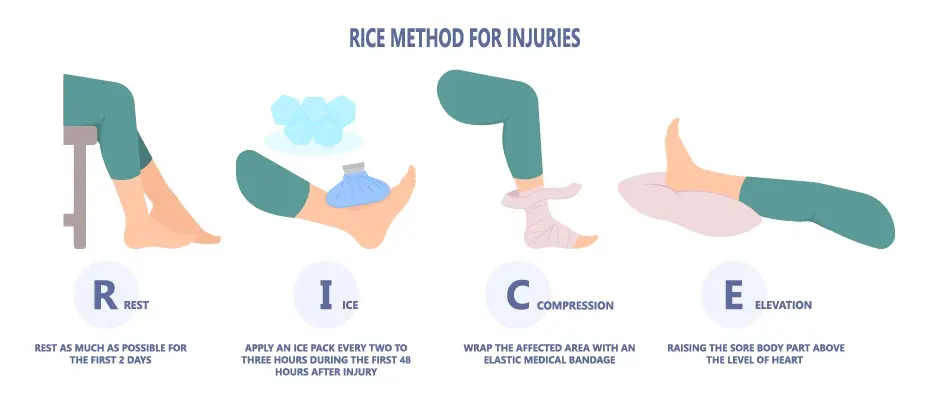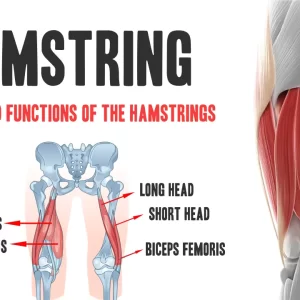Contents
What is an Ankle Sprain?
An ankle sprain occurs when the ligaments that support the ankle stretch beyond their limits or tear. Ligaments are tough bands of tissue that stabilize joints. Sprains commonly happen when the foot twists or rolls unexpectedly, causing the ankle joint to move out of its normal position .
What Causes an Ankle Sprain?
Ankle sprains typically result from:
- Twisting or rolling the ankle: Often during sports or walking on uneven surfaces.
- Falls: Landing awkwardly can force the ankle into an unnatural position.
- Sudden impact: Direct blows to the ankle can stretch or tear ligaments.
These incidents can overstretch or tear the ligaments, leading to a sprain .
What are the Symptoms of an Ankle Sprain?
Common symptoms include:
- Pain: Especially when bearing weight on the affected foot.
- Swelling: Due to inflammation.
- Bruising: Discoloration around the ankle.
- Limited range of motion: Difficulty moving the ankle.
- Instability: Feeling of the ankle giving way .
How is an Ankle Sprain Diagnosed?
Diagnosis involves:
- Physical examination: Assessing swelling, tenderness, and range of motion.
- Imaging tests: X-rays to rule out fractures; MRI or ultrasound for detailed ligament assessment .
Grading Severity of Ankle Sprains

Ankle sprains are commonly classified into three grades based on the extent of ligament damage. Understanding the severity of the sprain is essential for determining the appropriate treatment plan and expected recovery time.
Grade I Sprain (Mild)
- Ligament Condition: Overstretching without tearing.
- Joint Instability: Little to none.
- Pain and Swelling: Mild.
- Mobility Impact: Minor difficulty with walking.
- Treatment: Conservative care such as rest, ice, compression, and elevation (R.I.C.E.); usually no long-term complications.
Grade II Sprain (Moderate)
- Ligament Condition: Partial tearing of ligament fibers.
- Joint Instability: Mild to moderate.
- Pain and Swelling: Moderate to severe.
- Mobility Impact: Some difficulty walking; mild bruising is often present.
- Treatment: May require a brace or splint; physical therapy is often recommended for recovery and to prevent reinjury.
Grade III Sprain (Severe)
- Ligament Condition: Complete ligament rupture.
- Joint Instability: Significant.
- Pain and Swelling: Severe.
- Mobility Impact: Marked difficulty or inability to walk due to intense pain.
- Treatment: Requires medical evaluation; immobilization, physical therapy, and in some cases surgical intervention may be necessary.
The grade/severity of a ankle sprain plays a critical role in shaping the treatment approach. While mild cases can often be managed at home, more severe sprains demand medical attention from a physician and/or rehabilitation support from a licensed physical therapist.
What is Good for an Ankle Sprain?

Initial care includes the R.I.C.E. method:
- Rest: Avoid activities that cause pain.
- Ice: Apply ice packs for 15-20 minutes every 2-3 hours.
- Compression: Use elastic bandages to reduce swelling.
- Elevation: Keep the ankle raised above heart level .
Over-the-counter pain relievers like ibuprofen can help manage pain and inflammation.
What are the Risk Factors for an Ankle Sprain?
Risk factors include:
- Previous ankle injuries: Increases susceptibility to future sprains.
- Sports participation: Especially in sports requiring jumping or quick directional changes.
- Uneven surfaces: Walking or running on irregular terrain.
- Inadequate footwear: Wearing shoes that don’t provide proper support .
Frequently Asked Questions About Ankle Sprain
Q: How long does it take to recover from an ankle sprain?
A: Recovery time varies. Mild sprains may heal in a few days, while severe sprains can take several weeks to months.
Q: When should I see a doctor?
A: If you experience severe pain, cannot bear weight, or notice significant swelling or deformity, consult a healthcare provider.
Q: Can I prevent ankle sprains?
A: Yes. Strengthening exercises, proper footwear, and being cautious on uneven surfaces can help prevent sprains.
References
- Sprained Ankle: Symptoms, Types, Treatment & Recovery. Cleveland Clinic. https://my.clevelandclinic.org/health/diseases/22048-sprained-ankle
- Sprained ankle – Symptoms and causes. Mayo Clinic. https://www.mayoclinic.org/diseases-conditions/sprained-ankle/symptoms-causes/syc-20353225
- Sprained Ankle – OrthoInfo – AAOS. https://orthoinfo.aaos.org/en/diseases–conditions/sprained-ankle/
- Ankle Sprain and Strain Risk Factors – Sports-health. https://www.sports-health.com/sports-injuries/ankle-and-foot-injuries/ankle-sprain-and-strain-risk-factors



